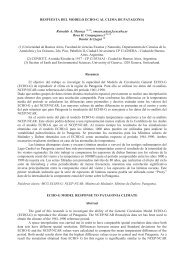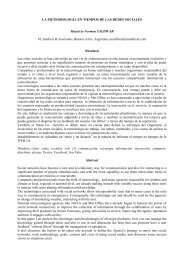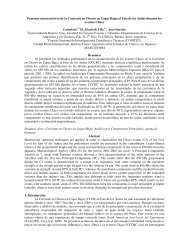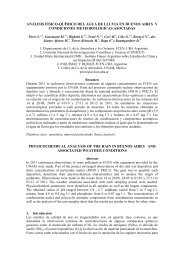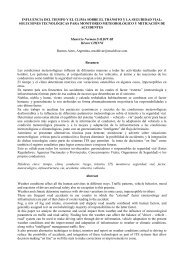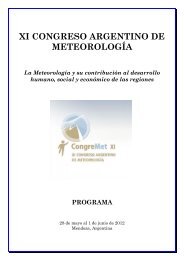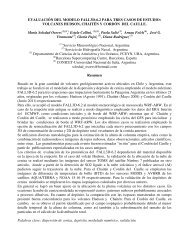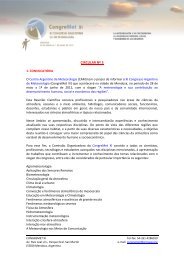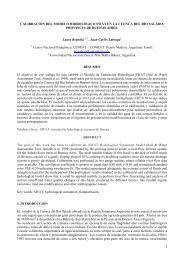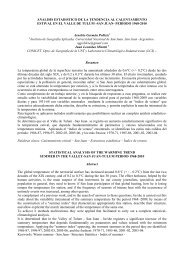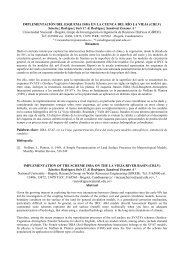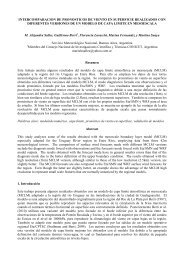5. ConclusionesEste trabajo presenta el modelo Semi-Empirical Urban Street (<strong>SEUS</strong>). <strong>SEUS</strong> es un modelo simple de cañónurbano que permite estimar la concentración de contaminantes en aire dentro de un cañón urbano en funcióndel caudal másico de contaminantes emitidos por unidad de longitud, del ancho del cañón, de la velocidaddispersiva (que depende de las fluctuaciones de la velocidad del viento y las debidas al movimiento de losautomotores) y de la concentración de fondo. La turbulencia natural del aire y la generada por los vehículospueden ser expresadas en función de dos parámetros adimensionales (a y b, respectivamente). A partir de losdatos obtenidos en cuatro cañones urbanos en Göttinger Strasse (Hannover), Schildhornstrasse (Berlín),Jagtvej (Copenhague) y Hornsgatan (Estocolmo), se encontraron las formas funcionales de a y bincorporadas en el modelo <strong>SEUS</strong>.Se estudió la sensibilidad de las estimaciones |δC/C| del modelo <strong>SEUS</strong> a las variaciones de la magnitud decada parámetro (p) mediante |δC/C|= K |δp/p|, aplicando el método de propagación de errores. Como eraesperable, las variaciones relativas de la emisión, del ancho del cañón y de la concentración de fondo urbano,generan similares variaciones relativas en C, dado que, para estas variables K=1. En condiciones debarlovento, K= 1 para |δU/U| y K=0,5 para |δa/a|. En condiciones de sotavento, las variaciones relativas|δU/U| y |δV/V| producen variaciones relativas menores en C debido a que 0,001 ≤K≤ 0,99. En general, lasvariaciones relativas de a y b tienen menor influencia en |δC/C| que las variaciones de otras variables, porque|δa/a| y |δb/b| están multiplicadas por 0,5[aU 2 /(aU 2 + bV 2 )] y 0,5[bV 2 /(aU 2 + bV 2 )], respectivamente, quepueden variar entre 0,0005 y 0,50.El modelo <strong>SEUS</strong> fue aplicado operativamente para estimar las concentraciones horarias de NO x en aire endos cañones atípicos, irregulares y complejos localizados, uno en la Av. Córdoba (ciudad de Buenos Aires) yotro en el Boulevard Andersen (ciudad de Copenhague). Los resultados de la comparación de los valoresestimados con los datos observacionales se sintetizan a continuación:• “cañón” urbano de la Av. Córdoba (Buenos Aires):Considerando todas las direcciones de viento, el error cuadrático medio normalizado es 35%, el FA2=73% y FB= -0,083. En este caso, el modelo <strong>SEUS</strong> sobrestima levemente los valores observados.Considerando las condiciones de sotavento, barlovento y de direcciones de viento paralelas al eje delcañón, el desempeño del <strong>SEUS</strong> es diferente en cada una de ellas. El mismo es mejor en los casos desotavento (FA2=86%) subestimando levemente (FB= 0.068) las concentraciones observadas. Encondiciones de barlovento y de direcciones del viento paralelas al eje del cañón, el modelo <strong>SEUS</strong>sobrestima los valores observados.• “cañón” urbano del Boulevard Andersen (Copenhague):Considerando todas las direcciones de viento, el error cuadrático medio normalizado es 33%, el FA2=76% y FB= 0,218. En este caso, el modelo <strong>SEUS</strong> subestima ligeramente los valores observados.Considerando condiciones de sotavento, barlovento y de direcciones de viento paralelas al eje del cañón,el desempeño del modelo <strong>SEUS</strong> también resultó diferente en cada una de ellas. Como en el cañón deBuenos Aires, los mejores resultados del modelo <strong>SEUS</strong> se presentan en condiciones de sotavento(FA2=85%), sobrestimando levemente (FB=-0.078) las concentraciones observadas. En los casos debarlovento y con direcciones del viento paralelas al eje del cañón, el modelo <strong>SEUS</strong> subestima los valoresobservados.La comparación de los resultados del modelo <strong>SEUS</strong> con los valores observados en los “cañones” urbanos dela ciudad de Buenos Aires y de Copenhague resultó alentadora. Es propósito de los autores realizar futurascomparaciones con datos observacionales provenientes de otros cañones urbanos.AgradecimientosLos autores agradecen el apoyo del Consejo Nacional de Investigaciones Científicas y Técnicas, ProyectoCONICET-PIP 0304; a la Agencia de Protección Ambiental del Gobierno de la ciudad de Buenos Aires y alServicio Meteorológico Nacional por la información utilizada en la aplicación de <strong>SEUS</strong> en la Av. Córdoba yal National Environmental Research Institute, AArhus University (Dinamarca) por la información utilizadaen la aplicación de <strong>SEUS</strong> en el Boulevard Andersen.
ReferenciasBerkowicz, R. 2000. OSPM – A parameterised street pollution model. Environmental Monitoring &Assessment, 65, 323-331.Berkowicz, R., Palmgren, F., Hertel, O. y Vignati, E. 1996. Using measurements of air pollution in streetsfor evaluation of urban air quality – meteorological analysis and model calculations. The Science of the TotalEnvironment, 189/190, 259-265.Blocken, B.; Janssen, W.D. y van Hooff, T. 2012. CFD simulation for pedestrian wind comfort and windsafety in urban areas: General decision framework and case study for the Eindhoven University campus.Environmental Modelling & Software, 30, 15-34.Buckland, A.T. 1998. Validation of a street model in two cities. Environmental Monitoring & Assessment,52, 255-267.Chang, J.C. y Hanna, S.R. 2004. Air quality model performance evaluation. Meteorological AtmosphericPhysics, 87, 167-196.GCBA, 2006. Gobierno de la Ciudad de Buenos Aires. Informes sobre Índice de Tránsito.GCBA-ACOM. 2006. Mapa Estratégico de Ruido-Ciudad Autónoma de Buenos Aires, Gobierno de laCiudad Autónoma de Buenos Aires y Asociación Civil Oir Mejor.Hilst, G.R. 1970. Sensitivities of air quality prediction to input errors and uncertainties. In: Proc. ofSymposium on multiple-source urban diffusion models. US.EPA. Research Triangle Park. NC.Jakeman A. J., Letcher R. A. y Norton J. P. 2006. Ten iterative steps in development and evaluation ofenvironmental models. Environmental Modelling & Software 21, 602-614.Johnson, W.B., Ludwig, F.L., Dabberdt, W.F. y Allen, R.J., 1971. Development and initial evaluation of anurban diffusion model for carbon monoxide. Sixty fourth annual meeting, American Institute of ChemicalEngineers.Kastner-Klein, P., Berkowicz, R. y Plate, E. J. 2000. Modelling of vehicle induced turbulence in air pollutionstudies for streets. Int. J. Environment and Pollution, 14, 496-507.Kastner-Klein, P., Fedorovich, E., Ketzel, M., Berkowicz, R. y Britter, R. E. 2003. The modelling ofturbulence from traffic in urban dispersion models- Part II. Evaluation against laboratory and full-scaleconcentration measurements in street canyons. Environmental Fluid Mechanics, 3, 145-172.Ketzel M., Berkowicz R., Lohmeyer A., Kastner-Klein P. y Flassak T. 2001. Adaptation of results fromCDF-models and wind-tunnels for practical traffic pollution modelling. Proceedings of the 7 th InternationalConference on Harmonisation within Atmospheric Dispersion Modelling, 261-265.Kim, M.J, Park, R.J. y Kim, J-J. 2012. Urban air quality modeling with full O 3 -NO x -VOC chemistry:Implications for O 3 and PM air quality in a street canyon. Atmospheric Environment, 47, 330-340.Mazzeo, N.A. y Venegas, L.E. 1991. Air pollution model for an urban area. Atmospheric Research, 26, 165-179.Mazzeo, N.A. y Venegas, L.E. 2005. Evaluation of turbulence from traffic using experimental data obtainedin a street canyon. Int. J. Environment and Pollution, 25, 164-176.Mazzeo, N.A. y Venegas, L.E. 2009. Air pollution dispersion inside a street canyon of Göttinger Strasse(Hannover, Germany) – New results of the analysis of full scale data. Int. J. Environment and Pollution, 40,1/2/3, 195-209.Mazzeo N. A. y Venegas, L. E. 2011. Study of natural and traffic-producing turbulences analysing full-scalefour street canyons. Int. J. Environment and Pollution, 47, 290-301.Mazzeo N.A., Venegas, L.E. y Dezzutti, M.C. 2011. Evaluation of air pollutant concentrations estimatedinside an asymmetric street canyon using different parameterisations of vehicle-induced turbulence.Proceedings of the 14 th International Conference on Harmonisation within Atmospheric DispersionModelling for Regulatory Purposes, 534-538.



